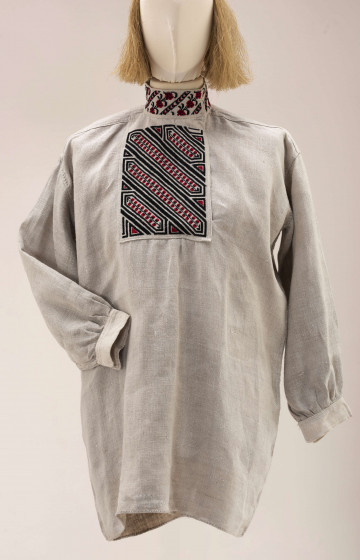
Skirt
1959
National Museum in Lublin
Part of the collection: Folk craft of the Lublin Region (19th/20th c.)
The item of women's clothing comes from the village of Okopy in the Chełm region, from the first half of the 20th century. It was worn with festive costumes in autumn and spring. During cold winters, it was put on over a sheepskin to protect against the cold. It was sewn by a tailor from homemade woollen material in the shape of a long poncho with two side gussets sewn in from the waist down. It is cut with three darts at the waist. It has gussets under the armpits of sleeves, which taper to the edges, where there is a small slit inside. The dress is decorated with a hem of red and blue cords, placed at both edges of the collar, at the full-length slit in red and up to the blue waist, and at the edge of the cuffs and side darts. Both front slits were overlapped, and the whole was tied at the waist with a selvedge.
In the Lublin area, dresses had three colours – white, grey (or blue) and black (or brown). Initially, the colours depended on the type of sheep bred and their coats (white and brown), and in the last period of functioning of sukmanas, the fashion for dyed blue ones was adopted, which in the Lublin region occurred only in the western part. According to Kazimierz Moszyński, in Kultura Ludowa Słowian [Folk Culture of Slavs], white and grey colours of cloths, called Małopolska cloths, with a more traditional cut, occurred in Polesie (except for the western part), in south-western Podlasie and the part of Małopolska extending through the area of Chęciny and Michów, up to Kraków. The predominance or exclusivity of the brown dress colour was in western Polesie and a significant part of Podlasie. Further on, it was predominantly or exclusively brown – in eastern Lesser Poland, i.e., Lubelskie, some areas of Radomskie and Kieleckie and in the south (except for Krakowskie, southern Lachia, western Lemkos and Podhale). Dress robes in women's costumes were replaced by kaftans and coats, called friendlies, modelled on urban fashion already at the turn of the 19th and 20th century.
Author / creator
Dimensions
cały obiekt: height: 42 cm, width: 120 cm
Object type
sukman
Technique
hand sewing
Material
cloth
Creation time / dating
Creation / finding place
Owner
The National Museum in Lublin
Identification number
Location / status

1959
National Museum in Lublin

1801 — 1900
National Museum in Lublin

1801 — 1900
National Museum in Lublin
DISCOVER this TOPIC
National Museum in Szczecin
DISCOVER this PATH
Educational path